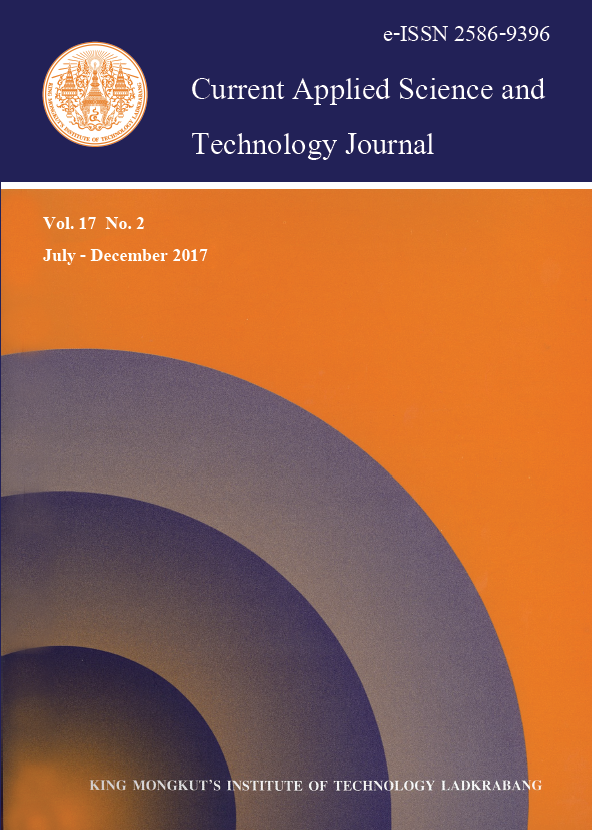Sensory Descriptive Analysis and Physicochemical Properties of Spirulinaplatensis from Different Drying Processes: Hot Air Drying and Microwave Vacuum Drying
Main Article Content
Abstract
This research compared the sensory and physicochemical characteristics of dried Spirulina (Spirulina platensis) using hot air drying (50ºC, 8 h) versus microwave vacuum drying (4800 watts, 40 min). Ten trained panelists received three months of training in terminology development, reference selection, intensity scaling (15 centimeter line scale) and warm up sample before conducting generic descriptive analysis. The sensory descriptive results identified 16 attributes of dried Spirulina: green-yellow color, particle size, four odors (fish, salty, seaweed, green), three tastes (salt, bitter, umami), three flavors (chicken, fish, algae) and four aftertastes (oily, bitter, pork, astringent). The method of drying (hot air versus microwave vacuum drying) affected the moisture content, color value (L*, a* and b*), total antioxidant activity, total phenolic compounds, color attribute, fishy odor, and seaweed odor of dried Spirulina with significant difference (p≤0.05). Microwave vacuum drying provided better color and aroma than the hot air drying (p≤0.05). The intensities of green-yellow color, fishy odor, and seaweed odor of Spirulina from hot air drying were 8.32±0.93, 5.83±0.77 and 8.10±0.51, respectively. Those from microwave drying were 5.27±0.80, 6.97±0.52, and 6.58±0.82, respectively. However, the taste, flavor and aftertaste of both dried Spirulinas did not differ significantly (p≥0.05). Nevertheless, the lower of total antioxidant activity and total phenolic compounds loss of dried Spirulina samples were found in sample from microwave vacuum drying. The two different drying methods used affected the physicochemical and sensory characteristics of dried Spirulina.
Keywords: Spirulina platensis, descriptive analysis, hot air drying, microwave vacuum drying
*Corresponding author:
E-mail: niramon.u@cmu.ac.th
Article Details
Copyright Transfer Statement
The copyright of this article is transferred to Current Applied Science and Technology journal with effect if and when the article is accepted for publication. The copyright transfer covers the exclusive right to reproduce and distribute the article, including reprints, translations, photographic reproductions, electronic form (offline, online) or any other reproductions of similar nature.
The author warrants that this contribution is original and that he/she has full power to make this grant. The author signs for and accepts responsibility for releasing this material on behalf of any and all co-authors.
Here is the link for download: Copyright transfer form.pdf
References
[2] Oliveira, E.G., Duarte, J.H., Moraes, K., Crexi, V.T. and Pinto L.A.A., 2010. Optimisation of Spirulina platensis convective drying evaluation of phycocyanin loss and lipid oxidation. International Journal of Food Science and Technology, 45, 1572-1578.
[3] Richmond, A., 1998. Spirulina. In: M.A. Borowitzka and L.J. Borowitzka. Micro-Algal Biotechnology. Cambridge: Cambridge University Press, pp.85-121.
[4] Costa, B.R., Rocha, S.F., Rodrigues, M.C.K., Pohndorf, R.S., Larrosa, A.P.Q. and Pinto, L.A.A., 2015. Physicochemical characteristics of the Spirulina sp. dried in heat pump and conventional tray dryers. International Journal of Food Science and Technology, 50, 2614-2620.
[5] Kepekci, R.A. and Saygideger., S.D., 2012. Enhancement of phenolic compound production in Spirulina platensis by two-step batch mode cultivation. Journal of Applied Phycology, 24, 897-905.
[6] Estrada, J.E.P., Bescos, P.B. and Fresno, A.M.V., 2001. Antioxidant activity of different fractions of Spirulina platensis protean extract. IL Farmaco, 56(5-7), 497-500.
[7] Krokida, M.K., Karathanos, V.T., Maroulis, Z.B. and Marinos-Kouris., D. 2003. Drying kinetic of some vegetables. Journal Food Engineering, 59(4), 391-403.
[8] Sarada, R., Pillai, M.G. and Ravishanker, G.A., 1999. Phycocyanin from Spirulina sp: Influence of processing of biomass on phycocyanin yield, analysis of efficacy of extraction methods and stability studies on phycocyanin. Process Biochemistry, 34(8), 795-801.
[9] Lawless, H.T., 1995. Dimensions of quality: a critique. Food Quality and Preferences, 6(3), 191- 196.
[10] Bleibaum, R.N., Stone, H., Tan, T., Labreche, S., Saint-Martin, E. and Isz, S. 2002. Comparison of sensory and consumer results with electronic nose and tongue sensors for apple juices. Food Quality and Preference, 13 (6), 409-422.
[11] AOAC, 2000. Official Method of Analysis of AOAC International. 17th ed. The Association of Official Analytical Chemists. Arlington, Virginia.
[12] Brand-Williams, W., Cuvelier, M.E. and Berset, C., 1995. Use of free radical method to evaluate antioxidant acitivity. LWT-FOOD Science and Technology, 8, 25-30.
[13] Sudha, S.S., Karthic, R., Rengaramanujam, J. and Athulya, M., 2011. Antimicrobial activity of Spirulina platensis and Aphanothrece sp. on selected clinical bacterial isolates and its antioxidant activity. South Indian Journal of Biological Sciences, 1(2), 87-98.
[14] Assis, L.M., Machado, A.R., Motta, A.S., Casta, J.A.V. and Souza-Soares, L.A., 2014. Development and characterization of nanovesicles containing phenolic compounds of microalgae Spirulina strain LEB-18 and Charella pyenoidosa. Advance in Materials Physics and Chemistry, 4, 6-12.
[15] Koru, E., 2012. Earth Food Spirulina (Arthrospira): Production and quality standarts, food additive, In: Yehia El-Samragy (ed), ISBN: 978-93-510067-6, [Online] Available at: https://www.intechopen.com/books/food-additive/earth-food-Spirulina-arthrospira-production -and -quality -standards.
[16] Inchuen, S., Narkugsa, W. and Pornchaloempong, P., 2010. Effect of drying method on chemical composition, color and antioxidant properties of Thai Red Curry powder. Kasetsart Journal (Natural Science), 44, 142-151.
[17] Kratchanova, M., Pavlova, E. and Panchev, I., 2003. The effect of microwave heating of fresh orange peels on the tissue and quality of extracted pectin. Carbohydrate Polymers, 56, 181-185.
[18] Garau, M.C., Simal, S., Rosselloo, C. and Femenia, A., 2007. Effect of air-drying temperature on physico-chemical properties of dietary fibre and antioxidant capacity of orange (Citusaurantiumv. Canoneta) by-products. Food Chemistry, 104(3), 1014-1024.
[19] Phillipa, K., Bremer, P., Silcock, P., Hamid, N., Delahunty, C., Barker, M. and Kissick, J., 2009. Effect of gender, diet and storage time on the physical properties and sensory of sea urchin (Evechinus chloroticus) gonads. Aquaculture, 288(3-4), 205-215.


